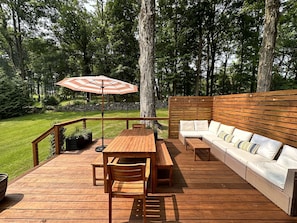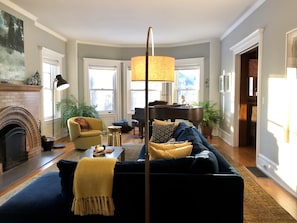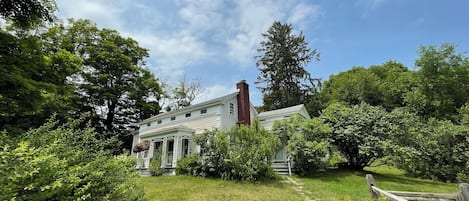Judge James Betts house was built in 1904 on former limestone quarry lands used for cement manufacture for construction of the Brooklyn Bridge. Kingston began as a historic Dutch settlement in the early 1600s, and was New York State's first capital, which the British promptly burned down (1777). Many pre-revolutionary war stone buildings have been restored, including NY's first Senate House. This brick home has 4500 square feet of high-ceiling, oversize rooms and three separate outdoor spaces for dining, games, enjoying sunsets, and sunbathing. Lawns for badminton and croquet. BBQ and fire pit. Four bedrooms sleep up to 8 adults. All bedrooms have individually controlled central a/c. Furnished for comfort and socializing, eat casually outdoors or in the kitchen, or in the formal dining room. A sun room for morning coffee and sipping wine at dusk all year round and a wrap around veranda is perfect for sunset. Solidly built and impeccably maintained, this property is a perfect headquarters for exploring Kingston's historic Stockade, Fair Street, Rondout and West Chestnut historic districts. A short distance to many other towns and attractions including Woodstock, Rhinebeck, New Paltz, Red Hook, Hyde Park and many tourist destinations for skiing. Kayaking, hiking, swimming, waterfalls, and caves to keep everyone active. Restaurants, bars, galleries, museums, river cruises, and enough history to engage all ages and interests.
History of the house, from "The Architectural History and Guide" Kingston, New York, edition, by William B. Rhoads, page 53.
6. Judge James Betts House, 1903
Given prominence by its raised site, the Betts house stands out as striving to project an aura of dignity through its use of Colonial or Georgian Revival forms. The symmetrical, five-bay facade of red brick, with white quoins and gambrel roof dormers and Palladian window of the second story, betray the circa 1900 date of the design.
The property was purchased in 1901 by James Betts from Luke Noone, owner of the nearby quarry and Italian villa whose style was wholly outmoded by 1904. Betts was a prominent Democrat and State Supreme Court judge. Governor Alfred E. Smith spent a 'social hour' at the Betts house on September 18th, 1920, after laying the cornerstone of the Roundout Creek Bridge.







